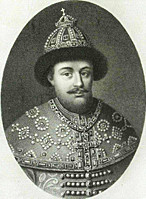
Aleksey Mikhailovich Romanov, Russian tsar, was born
19 (29) March 1629 was born Aleksey Mikhailovcih (Alexis of Russia), the second Russian tsar of the Romanov dynasty, the father of Peter I. During his rule was strengthened central state authority, serfdom was legalized; Ukraine was reunited with the Russian State (1654).
Aleksey Mikhailovich, the son of Mikhail Romanov from his marriage with Evdokia Lukyanovna Streshneva, ascended the throne in 1645. In the first years of his reign, the state was actually ruled by his mentor ("uncle") Boyar B. I. Morozov. Meek and religious Alexis was extremely loved by people, and earned the nickname "Quietest".
The main concern of the new government was replenishment of the treasury. To that end in 1646 under the tsar’s decree was increased the duty on salt. Due to the sharp rise in price of salt, people refused to buy it, the treasury income fell. In 1647 salt tax was repealed, but at the same time tax-paying population had to pay back arrears of taxes for the preceding two years. In 1648, widespread dissatisfaction among townspeople in Moscow led to the "Salt Riot". Aleksey Mikhailovich was forced to make concessions; Boyar Morozov was exiled to St. Kirillo-Belozersky Monastery, and his place at the courtyard took Boyar N. I. Romanov and Prince J. K. Cherkassky. Later, the tsar surrounded himself with Prince N. I. Odoevsky, diplomat A. L. Ordin-Nashchokin, Boyar A. S. Matveev.
In September 1648 the tsar convened a Zemsky Sobor, which adopted the Sobornoye Ulozhenie (Legal Code) (1649), which became a major piece of legislation of the Russian state for nearly two centuries. The Ulozhenie included special articles which regulated the legal status of certain social groups. Under the new law, the serfdom of the peasants became hereditary, and the search period of fugitive peasants - unlimited. Thus, the process of serfdom legalization was completed. Certain principles of law of Sobornoye Ulozhenie were in effect until the early 19th century.
From the early 1650's the young tsar begins himselft to take active part in governing. Under Alexis continued strengthening of autocratic, unlimited power of the sovereign. In the second half of 17th c. Zemsky Sobors were not convened, but a writ management system reached a peak. Established by Alexis the Privy Affairs Office (1654-1676) was directly subordinate to the tsar, and exercised control over the central and local institutions of government. The role of the Boyar Duma in governing diminished.
The government of Aleksey supported the interests of Russian merchants. Trade regulations, adopted by the tsar in 1653, marked the beginning of a single customs system in Russia. Trade and the New Trade Regulations (1667) protected the Russian merchants from foreign competitors. New trends in Russian life manifested themselves in the invitation of foreign experts to serve in Russia, the establishment of "alien" regiments.
The biggest success of Aleksey's foreign policy was the reunification of Ukraine and Russia (1654) and the return of the ancient Russian lands – Smolensk, Seversky land with Starodub and Chernigov (1667). Continued the development of Siberia, where new towns were founded: Nerchinsk (1658), Irkutsk (1659), Selenginsk (1666).
Failures in fiscal policy (issue of copper coins, which were equated with silver, which depreciated ruble) had caused people’s discontent, which, in 1662, grew into the Copper Riot in Moscow. In 1670 began the Cossack uprising led by Stepan Razin, supported by the masses, who were in a dire economic situation under the tax-paying and administrative oppression.
In the second half of 17th c. there were significant changes in traditional Russian culture: secular literature was introduced, including poetry, secular painting arose, the first "comic shows” were organized at the royal court. In 1652 Patriarch Nikon held ecclesiastical reform, which had great influence on the further development of the social life of the Russian state. The tsar himself, endorsing the patriarch, also took an uncompromising stance in the fight with the Old Belief.
Aleksey Mikhailovich was one of the most educated men of his time: he read petitions and other documents, wrote and edited many of the decrees, and was the first of the Russian tsars who signed them personally; he was directly involved in many military campaigns, led the foreign policy negotiations, increased control over the activities of Russian ambassadors. Besides, a number of literary works are ascribed to him, including "Message to Solovki, "The Tale of the Death of the patriarch Joseph”, etc.
Aleksey Mikhailovich was married twice. From his first marriage (1648) with Maria Ilyinichna Miloslavskaya were born 13 children, including the future rulers Fyodor, Ivan and Sophia, from his second marriage (1671) with Natalia Naryshkina - three children, including the future Emperor Peter I.
Aleksey Mikhailovich died on 30 January (9 February) 1676 at the age of 46 and was buried in the Archangel Cathedral of Moscow Kremlin.
Lit.: Андреев И. Л. Алексей Михайлович. М., 2006; Каптерев Н. Ф. Патриарх Никон и царь Алексей Михайлович. Сергиев Посад, 1909-12. Т. 1-2; Ключевский В. О. Царь Алексей Михайлович // Исторические портреты. Деятели исторической мысли. М., 1991; Медовиков П. Е. Историческое значение царствования Алексея Михайловича. М., 1854; Платонов С. Ф. Царь Алексей Михайлович. СПб., 1913; Повсядневных дворцовых времени государей царей и великих князей Михайла Феодоровича и Алексея Михайловича, записок. Ч. 1, 2. М., 1769; Талина Г. В. Царь Алексей Михайлович: личность, мыслитель, государственный деятель. М., 1996.
Based on the Presidential Library’s materials:

